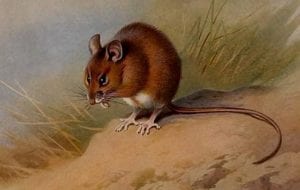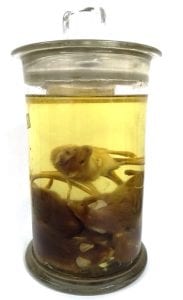Specimen of the week 339: The St Kilda mice
By ucwehlc, on 20 April 2018
Our specimens this week might be small, but they are giants of their species because of the peculiar effects of living on an island. They are…
**The St Kilda mice**
St Kilda
St Kilda is a remote archipelago 40 miles west of North Uist in the Outer Hebrides in Scotland. The islands are an important habitat for sea birds, such as gannets, puffins and skuas, and because of their remoteness they are home to some types of animals and plants that are not found anywhere else in the world. The St Kilda wren Troglodytes troglodytes hirtensis and St Kilda dandelion Taraxacum pankhurstianum occur only on the islands, and the archipelago is also the place of origin of the ancient and rare Soay and Boreray breeds of sheep.
The islands were also home to two subspecies of mice; the St Kilda house mouse Mus musculus muralis, and the St Kilda field mouse Apodemus sylvaticus hirtensis. Both subspecies were described by the extravagantly and repetitively named Gerald Edwin Hamilton Barrett-Hamilton in 1899.

St Kilda house mouse (Mus musculus muralis) by J Smit 1899, Proceedings of Zoological Society of London

St Kilda field mouse (Apodemus sylvaticus hirtensis), from British Mammals, Thorburn 1921. Copyright BHL CC BY 2.0
A tale of two mice
The first humans arrived in St Kilda in the Bronze Age or earlier, but the fist mice probably arrived with the Vikings. The St Kilda house mice lived in houses and other buildings on the islands and fed on stored food and rubbish in the settlements. The St Kilda field mice were less dependent on humans and had a broader diet.
On 29 August 1930 the last St Kildans left the islands, they evacuated because of the harsh climate, difficult way of life and falling population. Today there is a military base there all year round, and conservation biologists and tourists visit in the summer.
The house mouse became extinct within a few years of the permanent human population leaving the island, as it lost its sources of food and shelter. The field mouse fared better and expanded its niche to take over from the house mouse in the abandoned buildings on the islands. St Kilda is now world heritage site for both its historic and scientific importance.
The pattern of coloration on our mice suggest they are St Kilda field mice, although there are some specimens of the extinct house mouse in other museum collections.
Mighty Mouse
So what makes the St Kilda mice different to their relatives on the mainland? For one thing St Kilda field mice are up to twice as heavy. This is an example of the island rule where small species on islands tend to get larger to take advantage of having fewer predators and less competition (island gigantism), whereas large species tend to get smaller as there are fewer resources to support very large body size (island dwarfism). UCL scientist RJ Berry was studying this, and other aspects of island biogeography when he made a collection of over 8,000 island mice from around the world. Some of these mice can be seen in our wall of mice which has recently been returned to display.
As well as the mighty St Kilda mice, island gigantism also gave us the dodo (a huge, flightless pigeon), Archaeoindris, a gorilla-sized lemur and the 500Kg elephant bird, all of which are now extinct. The effect of island dwarfism can be seen in extinct dwarf mammoths, elephants and hippos from islands such as Crete, and even in Homo floresiensis, an extinct small species of human nicknamed the hobbit.
Hannah Cornish is the Curatorial Assistant at the Grant Museum of Zoology
References
Morton Boyd, 1956 The St. Kilda Field Mouse (Apodemus sylvaticus hirtensis Barrett-Hamilton), Population in the Village Area, Hirta, May 1955, Oikos Vol. 7, Fasc. 1 (1956), pp. 110-116
One Response to “Specimen of the week 339: The St Kilda mice”
- 1
 Close
Close





A very appropriate article, especially the wall of mice skeletons. Prof. R.J.(Sam) Berry collected most (maybe all) of these and on Monday 23rd we said farewell to him in a Thanksgiving celebration of his life at St Nicholas Church Sevenoaks. We will miss him but his work and mouse specimens remain to remind us of his achievements in evolutionary biology.